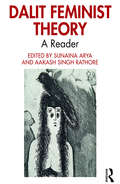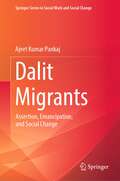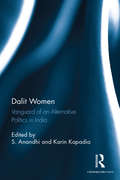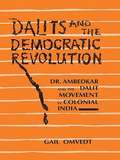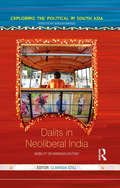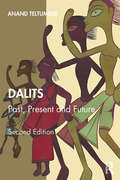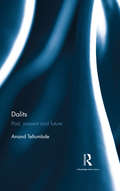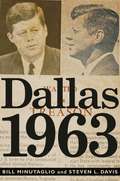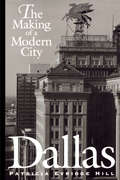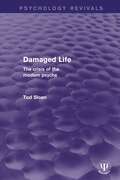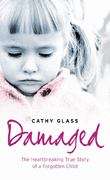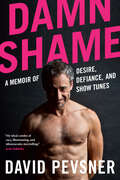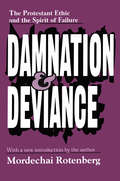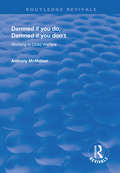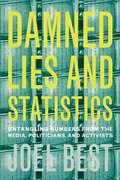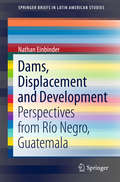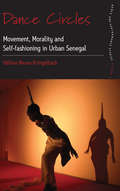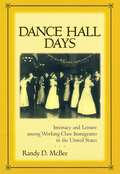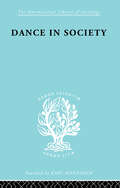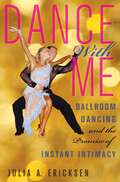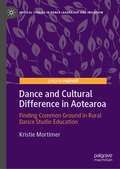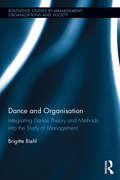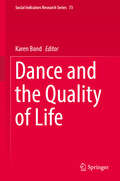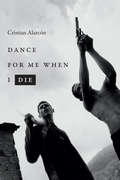- Table View
- List View
Dalit Feminist Theory: A Reader
by Aakash Singh Rathore Sunaina AryaDalit Feminist Theory: A Reader radically redefines feminism by introducing the category of Dalit into the core of feminist thought. It supplements feminism by adding caste to its study and praxis; it also re-examines and rethinks Indian feminism by replacing it with a new paradigm, namely, that caste-based feminist inquiry offers the only theoretical vantage point for comprehensively addressing gender-based injustices. Drawing on a variety of disciplines, the chapters in the volume discuss key themes such as Indian feminism versus Dalit feminism; the emerging concept of Dalit patriarchy; the predecessors of Dalit feminism, such as Phule and Ambedkar; the meaning and value of lived experience; the concept of Difference; the analogical relationship between Black feminism and Dalit feminism; the intersectionality debate; and the theory-versus-experience debate. They also provide a conceptual, historical, empirical and philosophical understanding of feminism in India today. Accessible, essential and ingenious in its approach, this book is for students, teachers and specialist scholars, as well as activists and the interested general reader. It will be indispensable for those engaged in gender studies, women’s studies, sociology of caste, political science and political theory, philosophy and feminism, Ambedkar studies, and for anyone working in the areas of caste, class or gender-based discrimination, exclusion and inequality.
Dalit Migrants: Assertion, Emancipation, and Social Change (Springer Series in Social Work and Social Change)
by Ajeet Kumar PankajThis book offers a detailed narrative of Dalit migrants' everyday experience in urban areas with regard to the availability and accessibility of welfare services and state institutions. It discusses caste, specifically the identity of integration for Dalit migrants and the social work profession to integrate a marginalized community. Further, the book also highlights social, political, cultural, and economic changes among Dalit migrants in cities.The book traces the trajectory of Dalit migrants and captures their mobility from rural to urban areas, which is a complex economic and social phenomenon. In consideration of this complexity, the author explores the process of migration in its finer details through a focus on lived experiences of Dalit migrants in cities. Dalits often migrate to cities in search of better employment and livelihood opportunities because their occupations are invariably associated with their caste in villages. This book investigates the role of caste-based identity in Dalit migrants’ emancipation and integration in cities. In addition, the book examines the role of caste in the exclusion of Dalit migrants in cities and explains the dynamic nature of the 'state' and Dalit migrants' assertion.Among the topics covered in the book's seven chapters:Mumbai/Bombay: Migration, Caste, and DalitsCaste and Migration: The City—A Site for ‘Inclusion’ and EmancipationEntitlement, Deprivation, and Basic Services: Everyday Experience of Dalit Migrants with the StateDalit Migrants: Assertion, Emancipation, and Social Change is intended for students, academicians, and researchers in social work, migration studies, labour studies, development studies, population science, and economics. Developmental professionals also will be keen to read the book.
Dalit Women: Vanguard of an Alternative Politics in India
by S. Anandhi Karin KapadiaThrough its investigation of the underlying political economy of gender, caste and class in India, this book shows how changing historical geographies are shaping the subjectivities of Dalits across India in ways that are neither fixed nor predictable. It brings together ethnographies from across India to explore caste politics, Dalit feminism and patriarchy, religion, economics and the continued socio-economic and political marginalisation of Dalits. With contributions from major academics this is an indispensable book for researchers, teachers and students working on new political expressions, gender identities, social inequalities and the continuing use of the notion of ‘caste’ identity in the oppression of subalterns in contemporary India. It will be essential reading in the disciplines of politics, gender, social exclusion studies, sociology and social anthropology.
Dalits and the Democratic Revolution
by Gail OmvedtThis important book traces the history of the Dalit movement from its beginning in the 19th century to the death of its most famous leader, B.R. Ambedkar, in 1956. Focusing on three states--Andhra,Maharashtra and Karnataka--Dr Omvedt analyses the ideology and organization of the movement and its interaction both with the freedom struggle(particularly with Gandhi and Gandhism) and the `class` struggles of the workers and peasants (and their dominant ideology-Marxism). She also provides a historical account of the origin and development of the caste system.
Dalits in Neoliberal India: Mobility or Marginalisation? (Exploring the Political in South Asia)
by Clarinda StillIndia’s economic growth has brought opportunities for many but to what extent has it benefitted its ethnically-shaped underclass: the Dalits? Have Dalits fared better in a neoliberal India or have structural economic and social changes served to magnify Dalit disadvantage? This volume offers a varied picture of Dalit experience in different states in contemporary India. The essays draw on factual research in rural and urban areas by experts in the field. With case studies ranging from Dalit entrepreneurs in Bhopal to housewives in Tamil Nadu to ex-millworkers in Mumbai, the book contends that radically progressive change and advance is attended by discrimination and exclusion, as well as surprising new areas of stigma. With contributions by political scientists, anthropologists, sociologists, and economists, the volume will be key reading for scholars and students of Dalit and subaltern studies, sociology, political science, and economics.
Dalits: Past, Present and Future
by Anand TeltumbdeThis book is a comprehensive introduction to Dalits in India from their origin to the present day. Despite a plethora of provisions for affirmative action in the Indian Constitution, Dalits still suffer exclusion on various counts. The book traces the multifarious changes that befell them through history, germination of Dalit consciousness during the colonial period and its f lowering under the legendary leadership of Babasaheb Ambedkar. It provides critical insights to their degeneration during the post-Ambedkar period, taking stock of all significant developments therein such as the rise of the Bahujan Samaj Party, Dalit capitalism, NGOization of the Dalit discourse and the various implicit or explicit emancipation schemas thrown up by them. It also discusses ideology, implicit strategy and tactics of the Dalit movement, touches upon one of the most contentious issues of increasing divergence between the Dalit and Marxist movements, and delineates the role of the state, both colonial and post-colonial, in shaping Dalit politics in particular ways. This new edition includes a new chapter providing the causal analysis of the rise of Hindutva under Narendra Modi, its fascist march obliterating the idea of India sketched out by the Constitution, and forecasts its future as the Hindu Rashtra – the Brahmanic-fascist state – which has been the goal of its progenitors. A tour de force, this book brings to the fore many key contemporary concerns and will be of great interest to activists, students, scholars and teachers of politics, political economy, sociology, anthropology, history and social exclusion studies.
Dalits: Past, present and future
by Anand TeltumbdeThis book is a comprehensive introduction to dalits in India (who comprise over one-sixth of the country’s population) from the origins of caste system to the present day. Despite a plethora of provisions for affirmative action in the Indian Constitution, dalits are largely excluded from the mainstream except for a minuscule section. The book traces the multifarious changes that befell them during the colonial period and their development thereafter under the leadership of Babasaheb Ambedkar in the centre of political arena. It looks at hitherto unexplored aspects of the degeneration of the dalit movement during the post-Ambedkar period, as well as salient contemporary issues such as the rise of the Bahujan Samaj Party, dalit capitalism, the occupation of dalit discourse by NGOs, neoliberalism and its impact, and the various implicit or explicit emancipation schemas thrown up by them. The work also discusses ideology, strategy and tactics of the dalit movement; touches upon one of the most contentious issues of increasing divergence between the dalit and Marxist movements; and delineates the role of the state, both colonial and post-colonial, in shaping dalit politics in particular ways. A tour de force, this book brings to the fore many key contemporary concerns and will be of great interest to students, scholars and teachers of politics and political economy, sociology, history, social exclusion studies and the general reader.
Dalits: Past, present and future
by Anand TeltumbdeThis book is a comprehensive introduction to dalits in India (who comprise over one-sixth of the country’s population) from the origins of caste system to the present day. Despite a plethora of provisions for affirmative action in the Indian Constitution, dalits are largely excluded from the mainstream except for a minuscule section. The book traces the multifarious changes that befell them during the colonial period and their development thereafter under the leadership of Babasaheb Ambedkar in the centre of political arena. It looks at hitherto unexplored aspects of the degeneration of the dalit movement during the post-Ambedkar period, as well as salient contemporary issues such as the rise of the Bahujan Samaj Party, dalit capitalism, the occupation of dalit discourse by NGOs, neoliberalism and its impact, and the various implicit or explicit emancipation schemas thrown up by them. The work also discusses ideology, strategy and tactics of the dalit movement; touches upon one of the most contentious issues of increasing divergence between the dalit and Marxist movements; and delineates the role of the state, both colonial and post-colonial, in shaping dalit politics in particular ways.A tour de force, this book brings to the fore many key contemporary concerns and will be of great interest to students, scholars and teachers of politics and political economy, sociology, history, social exclusion studies and the general reader.
Dallas 1963
by Bill Minutaglio Steven L. DavisIn the months and weeks before the fateful November 22nd, 1963, Dallas was brewing with political passions, a city crammed with larger-than-life characters dead-set against the Kennedy presidency. These included rabid warriors like defrocked military general Edwin A. Walker; the world's richest oil baron, H. L. Hunt; the leader of the largest Baptist congregation in the world, W.A. Criswell; and the media mogul Ted Dealey, who raucously confronted JFK and whose family name adorns the plaza where the president was murdered. On the same stage was a compelling cast of marauding gangsters, swashbuckling politicos, unsung civil rights heroes, and a stylish millionaire anxious to save his doomed city.Bill Minutaglio and Steven L. Davis ingeniously explore the swirling forces that led many people to warn President Kennedy to avoid Dallas on his fateful trip to Texas. Breathtakingly paced, DALLAS 1963 presents a clear, cinematic, and revelatory look at the shocking tragedy that transformed America. Countless authors have attempted to explain the assassination, but no one has ever bothered to explain Dallas-until now.With spellbinding storytelling, Minutaglio and Davis lead us through intimate glimpses of the Kennedy family and the machinations of the Kennedy White House, to the obsessed men in Dallas who concocted the climate of hatred that led many to blame the city for the president's death. Here at long last is an accurate understanding of what happened in the weeks and months leading to John F. Kennedy's assassination. DALLAS 1963 is not only a fresh look at a momentous national tragedy but a sobering reminder of how radical, polarizing ideologies can poison a city-and a nation.
Dallas: The Making of a Modern City
by Patricia Evridge HillFrom the ruthless deals of the Ewing clan on TV's "Dallas" to the impeccable customer service of Neiman-Marcus, doing business has long been the hallmark of Dallas. Beginning in the 1920s and 1930s, Dallas business leaders amassed unprecedented political power and civic influence, which remained largely unchallenged until the 1970s. In this innovative history, Patricia Evridge Hill explores the building of Dallas in the years before business interests rose to such prominence (1880 to 1940) and discovers that many groups contributed to the development of the modern city. In particular, she looks at the activities of organized labor, women's groups, racial minorities, Populist and socialist radicals, and progressive reformers-all of whom competed and compromised with local business leaders in the decades before the Great Depression. This research challenges the popular view that business interests have always run Dallas and offers a historically accurate picture of the city's development. The legacy of pluralism that Hill uncovers shows that Dallas can accommodate dissent and conflict as it moves toward a more inclusive public life. Dallas will be fascinating and important reading for all Texans, as well as for all students of urban development.
Damaged Life: The Crisis of the Modern Psyche (Psychology Revivals)
by Tod SloanWhat are the psychological problems caused by modernization? How can we minimize its negative effects? Modernization has brought many material benefits to us, yet we are constantly told how unhappy we are: crime, divorce, suicide, depression and anxiety are rampant. How can this contradiction be reconciled? Damaged Life, originally published in 1996, presents a powerful and progressive analysis of modernity’s impact on the psyche. Tod Sloan develops an integrated theory of the self in society by combining perspectives on personality development and socio-historical processes to explore our complex response to modernization. He discusses the implications of postmodern theory for psychology and proposes concrete responses to address the issue of mass emotional suffering. His book should be read not only by those working within psychology and related disciplines such as sociology and social policy, but also by anyone seeking enlightenment about the predicament of the self in contemporary society.
Damaged: The Heartbreaking True Story Of A Forgotten Child
by Cathy GlassAt the Social Services office, Cathy (an experienced foster carer) is pressured into taking Jodie as a new placement. Jodie's challenging behaviour has seen off five carers in four months. Despite her reservations, Cathy decides to accept Jodie to protect her from being put in an institution. Jodie arrives, and her first act is to soil herself, and then wipe it on her face, grinning wickedly. Jodie meets Cathy's teenage children, and greets them with a sharp kick to the shins. That night, Cathy finds Jodie covered in blood, having cut her own wrist, and smeared the blood over her face. As Jodie begins to trust Cathy her behaviour improves. Over time, with childish honesty, she reveals details of her abuse at the hands of her parents and other relatives. It becomes clear that Jodie's parents were involved in a sickening paedophile ring, with neighbours and Social Services ignoring the obvious signs. Jodie becomes increasingly withdrawn, and it's clear she needs psychiatric therapy. Cathy urges the Social Services to provide funding, but instead they decide to take Jodie away from her, and place her in a residential unit. Although the paedophile ring is investigated and brought to justice, Jodie¿s future is still up in the air. Cathy promises that she will stand by her no matter what. Her love for the abandoned Jodie is unbreakable.
Damn Shame: A Memoir of Desire, Defiance, and Show Tunes
by David PevsnerA funny, daring, bawdy and incredibly honest memoir from the anti-ageist, anti-body shaming, pro-sex advocate and erotic provocateur.Over the course of his 40-year career in show business, David Pevsner has done it all. He&’s acted on Broadway, off-Broadway, in independent films and on numerous TV network shows including Grey&’s Anatomy, Modern Family and Criminal Minds. As he continues his career in entertainment, Pevsner has also dedicated himself to exploring his deepest sexual fantasies. In his late 30s he became a mature male escort and over the last several years has attracted a large international fan base through his blog of erotic photographs celebrating nudity and sexuality. Damn Shame is David Pevsner&’s incredible story and is a passionate and poignant look at one man&’s journey from a thin, shy boy ashamed of his body and sexuality to a defiant, fearless everyman exploring his erotic desires, everything from leather and S&M to nude/erotic/hardcore modelling. Along the way, he fights back against society&’s demonization of gay sex, body shaming and ageism while pursuing his own very personal definition of success and seeking love, validation and self-esteem. Damn Shame gives a loud and powerful voice to a generation of mature men who have been conditioned to believe from society (and especially younger members of the gay community) that they are sexually irrelevant, old and undesirable. Pevsner&’s life story goes in directions that many couldn&’t imagine, but the lessons learned through his experiences will resonate with readers of every age.
Damnation and Deviance: The Protestant Ethic and the Spirit of Failure
by Mordechai RotenbergThe Calvinist view that man is predestined to be among the elect or the damned has profoundly influenced not only our views of criminals and deviants, but also the theoretical basis of correctional methods and psychotherapeutic techniques. In this provocative and original volume, Mordechai Rotenberg examines the impact of Protestant doctrine on Western theories of deviance. He explores the inherent contradiction between Protestant ethics, with its view of human nature as predestinated, and the "people-changing" sciences.Rotenberg presents empirical studies that show how people's tendency to label themselves and others as deviant can be predicted on the basis of their exposure to Western socialization. He contrasts alienating individuals, the result of competitiveness and exaggerated independence fostered by socialization in Protestant societies, to the reciprocal individualism of Hassidic, Japanese, and other non-Western cultures. Examining the Protestant "bias" of Western behavioral sciences, Rotenberg examines modern theories of deviance and proposes alternative models. He compares traditional past-oriented insight therapy, grounded in Calvinist methods of introspection, self-torment, and conversion, with Hassidic notions of redemption and salvation."Rotenberg provides important historical and sociological insights into the intellectual origins of modern theories of deviance. His argument that Western behavioral science retains a Calvinist view of humanity will force most scholars to examine anew the assumptions and foundations of their own theories."--Gerald N. Grob, Rutgers University"A highly original work, which should be of great interest to anyone concerned with relevant behavior. It shows how macro-definitions in a society tend to lead people to think about themselves and their ills in certain ways--and thus to deviate in certain ways."--Richard A. Cloward, co-author, Regulating the Poor: The Functions of Public Welfare
Damned If You Do, Damned If You Don't: Working in Child Welfare (Routledge Revivals)
by Anthony McMahonFirst published in 1998, Anthony McMahon details the accounts of public agency child welfare dealing abused and neglected children and their families and the pressures on child welfare workers. Opening up the discussion on the ambiguities whilst dealing with balancing child welfare work whilst dealing with the societal pressure of the non-intrusion into family life.
Damned Lies and Statistics: Untangling Numbers from the Media, Politicians and Activists
by Joel BestWhile startling statistics shape the thinking about social issues, the author attests that these numbers can be wrong. This book is a lively guide to spotting bad statistics and learning to think critically about these influential numbers.
Dams, Displacement and Development: Perspectives from Río Negro, Guatemala (SpringerBriefs in Latin American Studies)
by Nathan EinbinderUsing the case of the Chixoy Hydroelectric Dam in Guatemala, constructed between 1978 and 1983, this book examines the effects of displacement on the former residents of R#65533;o Negro, a community forcibly evicted and nearly eliminated by the military and paramilitary. Using open-ended interview discussions and testimonies, it focuses on this specific incident of displacement and violence and discusses the outcomes 30 years later. Guatemala's history is plagued by development projects that resulted in displacement, violence, and increased marginalization of its indigenous and non-indigenous populations. In order to make way for development initiatives such as the production of bananas, African palm, coffee and sugar cane; the extraction of metals such as gold and nickel; or, in this specific case, the construction of a hydroelectric dam, the land-based, predominately Maya campesinos have been systematically uprooted from the lands of their birth and launched into uncertainty. The research findings presented, based on fieldwork conducted from January to April 2009, suggest that the majority of survivors from the massacres that took place are still adversely affected by the destruction of their families and livelihoods. While the circumstances pertaining to this event are unique, similar struggles over land and human rights continue into the present -- and if policies remain unchanged, in both international development agencies as well as the Guatemalan government, clashes of this nature only increase in time.
Dance Circles
by Helene Neveu KringelbachSenegal has played a central role in contemporary dance due to its rich performing traditions, as well as strong state patronage of the arts, first under French colonialism and later in the postcolonial era. In the 1980s, when the Senegalese economy was in decline and state fundingwithdrawn, European agencies used the performing arts as a tool in diplomacy. This had a profound impact on choreographic production and arts markets throughout Africa. In Senegal, choreographic performers have taken to contemporary dance, while continuing to engage with neo-traditional performance, regional genres like the sabar, and the popular dances they grew up with. A historically informed ethnography of creativity, agency, and the fashioning of selves through the different life stages in urban Senegal, this book explores the significance of this multiple engagement with dance in a context of economic uncertainty and rising concerns over morality in the public space.
Dance Hall Days: Intimacy and Leisure Among Working-Class Immigrants in the United States
by Randy McBee&“A very important book . . . After you read it, you will never look into faces on the old dance photos in the same way.&” ―American Historical Review The rise of commercialized leisure coincided with the arrival of millions of immigrants to America's cities. Conflict was inevitable, as older generations attempted to preserve their traditions, values, and ethnic identities, while the young sought out the cheap amusements and sexual freedom offered by the urban landscape. At immigrant picnics, social clubs, and urban dance halls, Randy McBee discovers distinct and highly contested gender lines, proving that the battle between the ages was also one between the sexes. Free from their parents&’ strict rules governing sexual conduct, working women took advantage of their time in dance halls to challenge conventional gender norms. They routinely passed certain men over for dances, refused escorts home, and embraced the sensual and physical side of dance to accentuate their superior skills on the dance floor. Most men felt threatened by women&’s displays of empowerment and took steps to thwart the changes taking place. Accustomed to street corners, poolrooms, saloons, and other all-male get-togethers, working men tried to transform the dance hall into something that resembled these familiar hangouts. McBee also finds that men frequently abandoned the commercial dance hall for their own clubs, set up in the basements of tenement flats. In these hangouts, working men established rules governing intimacy and leisure that allowed them to regulate the behavior of the women who attended club events. The collective manner in which they behaved affected not only the organization of commercial leisure, but also men and women&’s struggles with and against one another to define the meaning of leisure, sexuality, intimacy, and even masculinity.
Dance In Society Ils 85 (International Library of Sociology)
by Frances RustThis is Volume II of nine in a collection on the Sociology of Culture. Originally published in 1969 this is an analysis of the relationship between the social dance and society in England from the Middle Ages to the 1960s.
Dance With Me: Ballroom Dancing and the Promise of Instant Intimacy
by Julia A. EricksenClick here to listen to Julia Ericksen's interview about Dance with Me on Philadelphia NPR's "Radio Times" Rumba music starts and a floor full of dancers alternate clinging to one another and turning away. Rumba is an erotic dance, and the mood is hot and heavy; the women bend and hyperextend their legs as they twist and turn around their partners. Amateur and professional ballroom dancers alike compete in a highly gendered display of intimacy, romance and sexual passion. In Dance With Me, Julia Ericksen, a competitive ballroom dancer herself, takes the reader onto the competition floor and into the lights and the glamour of a world of tanned bodies and glittering attire, exploring the allure of this hyper-competitive, difficult, and often expensive activity. In a vivid ethnography accompanied by beautiful photographs of all levels of dancers, from the world’s top competitors to social dancers, Ericksen examines the ways emotional labor is used to create intimacy between professional partners and between professionals and their students, illustrating how dancers purchase intimacy. She shows that, while at first glance, ballroom presents a highly gendered face with men leading and women following, dancing also transgresses gender.
Dance and Cultural Difference in Aotearoa: Finding Common Ground in Rural Dance Studio Education (Critical Studies in Dance Leadership and Inclusion)
by Kristie MortimerThis book provides a critical reflection on the ways dance studio teachers recognize, reflect and respond to cultural difference within their dance studio classes, particularly in the rural context in Aotearoa/New Zealand. Through dance teachers’ narratives, it reveals the complexities of multiculturalism within dance studio classes and examines related issues of inclusion and exclusion within dance education.Understanding the dance practices provided by teachers like those in rural communities within Aotearoa/New Zealand is an increasingly urgent concern in an era of growing political, social and cultural tensions, for students and scholars of performing arts, leadership and community development. While previous research and publications have investigated cultural difference and global multicultural arts practices, this book presents a critical lens on performing arts practice and socio-cultural challenges experienced by local dance teachers within rural communities in Aotearoa/New Zealand.
Dance and Organization: Integrating Dance Theory and Methods into the Study of Management (Routledge Studies in Management, Organizations and Society)
by Brigitte BiehlDance and Organisation is the first comprehensive work to integrate dance theory and methods into the study of management, which have developed an interest in the arts and the humanities. Dance represents dynamics and change and puts the moving body at the centre, which has been ignored and oppressed by traditional management theory. ‘Being’ a leader however also means to ‘move’ like one, and critical lessons can be learned from ballerinas and modern dancers. Leadership is a dialogue, as in the work of musicians, conductors and DJs who manage groups without words. Movement in organisational space, in a museum or a techno club can be understood as a choreography and site-specific performance. Movement also is practically used for leadership and employee development workshops and can be deployed as an organisational research method. By taking a firm interdisciplinary stance in dance studies and organisational research to explore management topics, reflecting on practitioner accounts and research projects, the book seeks to make an innovative contribution to our understanding of the moving body, generating new insights on teamwork, leadership, gender in management, organisational space, training and research methods. It comprises an important contribution to the organizational behaviour and critical management studies disciplines, and looks to push the boundaries of the academic literature.
Dance and the Quality of Life (Social Indicators Research Series #73)
by Karen BondThis is the first volume devoted to the topic of dance and quality of life. Thirty-one chapters illuminate dance in relation to singular and overlapping themes of nature, philosophy, spirituality, religion, life span, learning, love, family, teaching, creativity, ability, socio-cultural identity, politics and change, sex and gender, wellbeing, and more. With contributions from a multi-generational group of artists, community workers, educators, philosophers, researchers, students and health professionals, this volume presents a thoughtful, expansive-yet-focused, and nuanced discussion of dance’s contribution to human life. The volume will interest dance specialists, quality of life researchers, and anyone interested in exploring dance’s contribution to quality of living and being.
Dance for Me When I Die (Latin America in Translation)
by Cristian AlarcónOn the morning of February 6, 1999, Buenos Aires police officers shot and killed seventeen-year-old Víctor Manuel Vital, better known as Frente, while he was unarmed, hiding under a table, and trying to surrender. Widely known and respected throughout Buenos Aires's shantytowns for his success as a thief, commitment to a code of honor, and generosity to his community, Frente became a Robin Hood--style legend who, in death, was believed to have the power to make bullets swerve and save gang members from shrapnel. In Dance for Me When I Die—first published in Argentina in 2004 and appearing here in English for the first time—Cristian Alarcón tells the story and legacy of Frente's life and death in the context of the everyday experiences of love and survival, murder and addiction, and crime and courage of those living in the slums. Drawing on interviews with Frente's friends, family, and ex-girlfriends, as well as with local thieves and drug dealers, and having immersed himself in Frente's neighborhood for eighteen months, Alarcón captures the world of the urban poor in all of its complexity and humanity.
